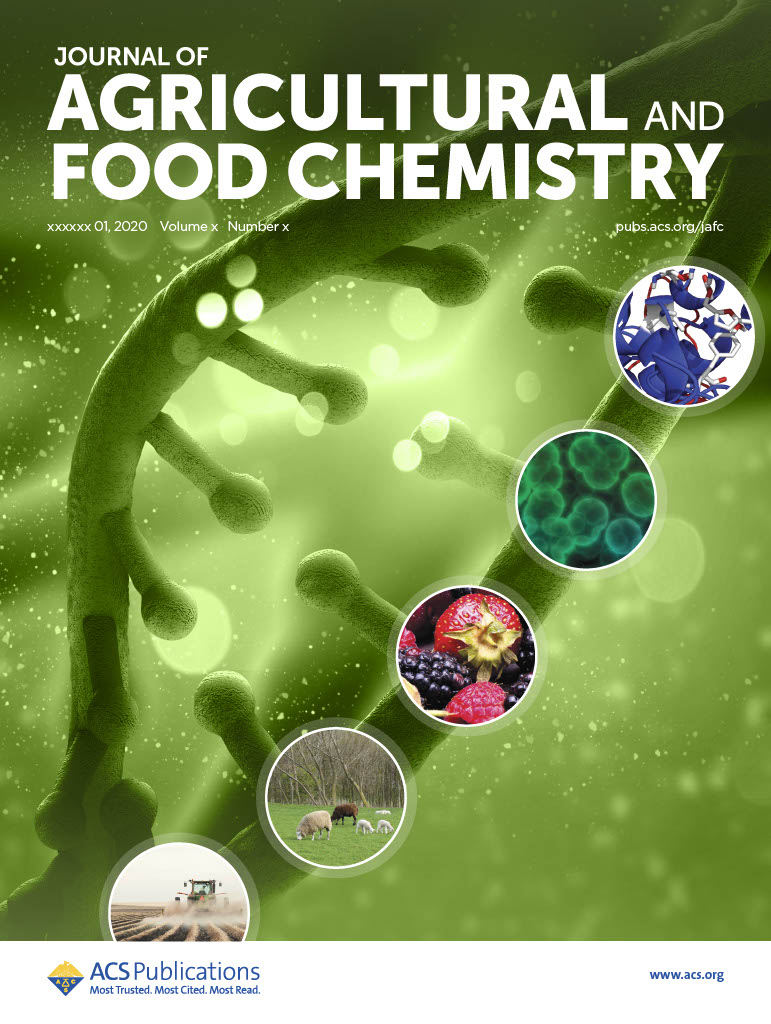The Journal of Agricultural and Food Chemistry (JAFC) and the ACS Divisions of Agrochemicals (AGRO) and Agricultural and Food Chemistry (AGFD) are pleased to announce the winners of the 2020 Journal of Agricultural and Food Chemistry Research Article of the Year Award. Launched in 2013, this award annually recognizes outstanding research work in the areas […]

The Journal of Agricultural and Food Chemistry (JAFC) and the ACS Divisions of Agrochemicals (AGRO) and Agricultural and Food Chemistry (AGFD) are pleased to announce the winners of the 2020 Journal of Agricultural and Food Chemistry Research Article of the Year Award. Launched in 2013, this award annually recognizes outstanding research work in the areas of agrochemicals and food chemistry with the support of the ACS Divisions of Agrochemicals and Agricultural and Food Chemistry.
Winner of the AGRO Division Best Research Article:
3-Chloro-5-trifluoromethylpyridine-2-carboxylic acid, a Metabolite of the Fungicide Fluopyram, Causes Growth Disorder in Vitis vinifera

In this research article, the authors identified and proposed a metabolite of the fungicide fluopyram, as the causing agent of phytotoxic damage on grapevines in the spring and summer of 2015 in several countries in Europe. Through greenhouse and field trials, the metabolite of fluopyram, PCA (3-chloro-5-trifluoromethylpyridine-2-carboxylic acid), was shown to cause leaf epinasty, impaired berry development leading to crop loss, and root-growth anomalies, similar to auxin herbicides in a dose-dependent manner.
Winner of the AGFD Division Best Research Article:
Transglycosylation Forms Novel Glycoside Ethyl α‑Maltoside and Ethyl α‑Isomaltoside in Sake during the Brewing Process by α‑Glucosidase A of Aspergillus oryzae

In this research article, the authors investigated the contribution of enzymes produced by the fungus Aspergillus oryzae in the saccharification process of brewing Sake, a Japanese rice wine. The (agdA) gene of Aspergillus oryzae coding for the a-glucosidase A enzyme, was knocked out to identify which components of Sake were produced by AgdA’s enzymatic activity. The results identified two novel transglycosylation products that were found to be present in many commercially available types of sake as well as in the natural environment.
Congratulations to this year’s award recipients! The awards will be presented at the 2020 ACS Fall National Meeting in San Francisco, CA. Each award consists of an honorarium, a plaque, and travel expenses to attend the ACS National Meeting and present their research work. Each award recipient is invited to give a talk as part of each division’s regular symposium sessions. Research Article of the Year Awards will be accepted by an author representative on behalf of the co-authors of the winning articles.
Accepting The Best Research Article Award (AGRO Division) on behalf of all co-authors: Dr. Peter Robatscher and Dr. Michael Oberhuber
Dr. Peter Robatscher is a chemist and scientist at the Laimburg Research Centre in Pfatten (Vadena), Italy. In 2003, he received a Ph.D. in Chemistry from the University of Innsbruck, Austria, with a thesis on the synthesis of amino acid building blocks. In 2004, he joined Laimburg Research Centre, where he analyzed pesticides and agrochemicals in agricultural products. Since 2011 he is head of the Laboratory for Flavours of Metabolites, located at NOI Techpark in Bolzano, Italy. His group is working in the field of food quality, traceability, and plant health by applying targeted and untargeted metabolomics on food and plant extracts.

Dr. Michael Oberhuber is the director of the Laimburg Research Centre in Pfatten (Vadena), Italy, since 2009. He holds an MSc. and a Ph.D. in chemistry from the University of Innsbruck, Austria. During his Ph.D. thesis, he investigated the molecular processes of autumnal leave senescence, unraveling the secrets of the fall colors.
In 2003, he moved to Skaggs Institute for Chemical Biology at The Scripps Research Institute in San Diego, CA, to study molecular evolution and the origin of life. Back in Europe, he joined Sandoz Development Centre at Sandoz/Novartis (Kundl, Austria) as the laboratory head for the development of pharmaceuticals.
His research interests include agricultural chemistry, nutrition, natural products, and chemical biology aimed to improve the competitiveness and sustainability of local agricultural production.
Accepting The Best Research Article Award (AGFD Division) on behalf of all co-authors: Dr. Masafumi Tokuoka

Dr. Masafumi Tokuoka is an Associate Professor at Tokyo University of Agriculture in Japan. His education includes a Ph.D. in Agriculture from the Department of Bioindustrial Informatics and Genomics, Graduate school of Agricultural Science at Tohoku University. His Ph. D. thesis theme was heterologous gene expression of Aspergillus oryzae. He is currently an Associate Professor in the Department of Fermentation Science and Technology at Tokyo University of Agriculture. Dr. Masafumi Tokuoka current work is focusing on the elucidation of unique metabolites in traditional Japanese foods and liquors, especially “sake” based on LC-MS analysis and gene engineering of Aspergillus oryzae strain.
The ACS Publications Division would like to thank the Journal of Agricultural and Food Chemistry Associate Editors who nominated articles for the 2020 awards, and to the AGRO and AGFD division member contributions to the winners’ selection committee. The Journal of Agricultural and Food Chemistry hopes to see many of its readers and authors at the Fall 2020 ACS National Meeting in San Francisco, CA. Please do join us at the symposia honoring these best research article awards to celebrate their prestigious and exciting achievement.
Previous Award-Winning Papers:
2019
Bioactivity-Guided Metabolite Profiling of Feijoa (Acca sellowiana) Cultivars Identifies 4-Cyclopentene-1,3-dione as a Potent Antifungal Inhibitor of Chitin Synthesis
DOI: 10.1021/acs.jafc.7b06154
***
Yeast Metabolites of Glycated Amino Acids in Beer
DOI: 10.1021/acs.jafc.8b01329
2018
Identification of the Ubiquitous Antioxidant Tripeptide Glutathione as a Fruit Fly Semiochemical
DOI: 10.1021/acs.jafc.7b03164
***
A Search for CD36 Ligands from Flavor Volatiles in Foods with an Aldehyde Moiety: Identification of Saturated Aliphatic Aldehydes with 9–16 Carbon Atoms as Potential Ligands of the Receptor
DOI: 10.1021/acs.jafc.7b01890
2017
Quantitation of Aristolochic Acids in Corn, Wheat Grain, and Soil Samples Collected in Serbia: Identifying a Novel Exposure Pathway in the Etiology of Balkan Endemic Nephropathy
DOI: 10.1021/acs.jafc.6b02203
***
Toxicologically Relevant Aldehydes Produced during the Frying Process Are Trapped by Food Phenolics
DOI: 10.1021/acs.jafc.6b02165
2016
Oxyphytosterols as Active Ingredients in Wheat Bran Suppress Human Colon Cancer Cell Growth: Identification, Chemical Synthesis, and Biological Evaluation
DOI: 10.1021/jf506361r
***
Olfactory Cues from Different Plant Species in Host Selection by Female Pea Moths
DOI: 10.1021/jf505934q
2015
NMR-Based Metabolomic Investigation of Bioactivity of Chemical Constituents in Black Raspberry (Rubus occidentalis L.) Fruit Extracts
DOI: 10.1021/jf404998k
***
Identification of Plant Metabolites of Environmental Contaminants by UPLC-QToF-MS: The in Vitro Metabolism of Triclosan in Horseradish
DOI: 10.1021/jf404784q
2014
Different Phenolic Compounds Activate Distinct Human Bitter Taste Receptors
DOI: 10.1021/jf304198k
***
Antifungal Activity against Plant Pathogens of Metabolites from the Endophytic Fungus Cladosporium cladosporioides
DOI: 10.1021/jf400212y
2013
Identifying New Lignin Bioengineering Targets: Impact of Epicatechin, Quercetin Glycoside, and Gallate Derivatives on the Lignification and Fermentation of Maize Cell Walls
DOI: 10.1021/jf203986a
***
Human Psychometric and Taste Receptor Responses to Steviol Glycosides
DOI: 10.1021/jf301297n
